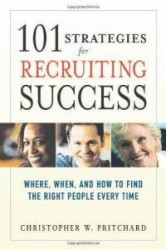Recently I had the opportunity to review the book 101 Strategies for Recruiting Success by Christopher Pritchard for the SHRM Store. As an HR Generalist for a small company, recruiting is one of those activities that I do occasionally but not often enough to really be creative. I learned some great ideas from the book that I\’m looking forward to testing out, and I\’d like to share seven of them.
 Develop a process map (pg 26)-Recently we took a few hours to map out our new hire process to help the operations team have input into how they would like to be notified and to make sure we are completing all necessary tasks associated with a new hire. One of our ninja admins developed a high-level flow chart and a set of checklists designed for accounting, HR, security, and administrative tasks. Having this in place ensures that the team is on the same page.
Develop a process map (pg 26)-Recently we took a few hours to map out our new hire process to help the operations team have input into how they would like to be notified and to make sure we are completing all necessary tasks associated with a new hire. One of our ninja admins developed a high-level flow chart and a set of checklists designed for accounting, HR, security, and administrative tasks. Having this in place ensures that the team is on the same page.- Do a customer satisfaction survey (pg 34)-Wouldn\’t you like to know if you are doing well or not? I would! The author suggests using a very simple, two question survey sent to hiring managers (or you can be really open and honest and send it to candidates as well!), including the following questions: Are you A) very satisfied, B) somewhat satisfied, or C) dissatisfied with the recruiting process? What would you improve?
- Provide status updates to candidates, managers, and up the chain (pg 35)-I know that we often hear about candidates needing updates on the status of the process, but it\’s even more important to make sure hiring managers know the status of the hiring process, too. I work with remote leaders and try to update them once every day or two on any pertinent updates to their candidates. Keep everyone in the loop that needs to be!
- Use metrics to gauge performance (pg 38)-We use metrics for other activities, so why not for recruiting? I\’m not a fan of the normal “time to fill†metric, because it can be misleading and difficult to calculate if there are a lot of starts and stops in the process due to managerial needs. The book mentioned a “submission to hire†ratio that I did like. Basically you look at how many candidates it takes to get a hire (10 to 1, for instance). Then try to work on narrowing that gap to 5 to 1 to save time and resources.
- Reach out to alumni (pg 57)-Assuming the people left in good standing, they could be fantastic resources for referrals or other information. We have two people who left but were thrilled with the experience they had with us. They just wanted to do more of what they love, and we couldn\’t offer that at this time. Just because they are gone doesn\’t mean they won\’t help if asked sincerely.
- Utilize military outplacement programs (pg 67)-We often hear the statistics, but the truth needs to be said. The unemployment rate for veterans is higher than the national average. What are we going to do about it? Well, we\’re going to look into programs like Operation Impact and work with organizations (local and national) such as Still Serving Veterans to try and find qualified candidates to fill our positions. If they can lead a group of men and women into battle to protect our freedoms, don\’t you think they are worth your time to consider for a position?
- Pre-close candidates (pg 120)-I\’m a big fan of this one. It\’s all about preparing candidates by getting them excited about the position, manager, and company. If they are emotionally invested, then there is a good chance they will take the interviews seriously and do their best to get the job. I\’d rather have 3 great candidates fighting for a position than 3 so-so candidates who we wouldn\’t want to hire anyway.
There was one “bonus†idea that made me stop and think. Utilize internal promotions when possible. I\’ve pushed for it in my own organization, but sometimes it slips your mind when a hiring manager reaches out to open a requisition for a new position. In my mind, it\’s usually easier to promote from within and recruit for the lower level/less experienced position than it is to find someone from outside who is unfamiliar with the organization yet capable of filling the role.
Again, here\’s the link to the book. If you\’re one of those generalists who does recruiting on the side, or if you are new to recruiting and looking to fill your toolbox with ideas to try out, I think 101 Strategies for Recruiting Success is a great book for you.
Do you practice any of these at your own company? Which have you had success with?
Good tips and I really like #5 – reach out to alumni. Makes sense.
Pingback: The Carnival of HR | HR Locksmith